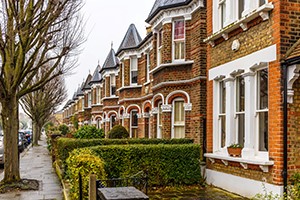Trending up
UK Finance’s mortgage trends updated for November 2017, released this week, revealed steady increases in mortgage lending for first-time buyers and home movers compared to the previous month and the equivalent period in 2016.
 The data shows housing market activity remains buoyant, despite November’s rise in the base rate. According to the trade body that represents major lenders in the UK highlight that increases in lending for house purchases together with increases in homeowner remortgages reflect a keenness among consumers to benefit from still historically low interest rates, and a highly competitive marketplace.
The data shows housing market activity remains buoyant, despite November’s rise in the base rate. According to the trade body that represents major lenders in the UK highlight that increases in lending for house purchases together with increases in homeowner remortgages reflect a keenness among consumers to benefit from still historically low interest rates, and a highly competitive marketplace.
In contrast, the update indicates declines in buy-to-let lending reflecting the changing regulatory and fiscal environment for landlord businesses, which might result in some landlords being inclined to reappraise the viability of their portfolios.
Keep on Moving
The number of people moving home is at its highest level since 2007. The number of homemovers – current homeowners moving house – across the UK increased by 2% to an estimated 370,300 in the past year, according to the latest Lloyds Bank Homemover Review.
The slight increase in homemovers could be a result of continued low mortgage rates and high demand for homes, which have made it easier for homemovers to take the next step on the housing ladder. The increase in 2017 follows a decline in the number of homemovers reported in 2016, which fell for the first in fi ve years. Since hitting a market low of 315,000 in 2009, the number of homemovers has grown by 18% (or 55,300). However, the current number is still 43% below the level of 653,700 seen in 2007.
ve years. Since hitting a market low of 315,000 in 2009, the number of homemovers has grown by 18% (or 55,300). However, the current number is still 43% below the level of 653,700 seen in 2007.
High house prices in London have adversely impacted the homemover market in the capital, with numbers of homemovers falling by 6% to 22,600 in the past year – the only region to have a decline in numbers. The South East region has the highest number of homemovers at 65,400 – more than double the next highest region, South West with 27,500. Northern Ireland has the lowest number at 4,400. Over the past five years, the average price paid by homemovers has grown by 44% (£90,879) from £205,852 in 2012, to £296,731 in 2017.
In London, the average price a homemover pays has grown by 59% since 2012 to £568,816, the highest in the UK. The average homemover price in the capital is 40%, or £161,429, higher than the South East (£407,386) which is the second most expensive. Northern Ireland has lowest average price of £164,878. The average deposit put down by a homemover has also increased by 45% in the past five years, from £69,089 in 2012 to £100,387 in 2017. Londoners require the largest deposit of £196,535 towards the purchase of their next home, which is four times the average homemover deposit of £46,032 in Northern Ireland. However, whilst Londoners pay the highest deposit in monetary terms, homemovers in East Anglia pay the largest deposit as a proportion of average house price – 37% (£110,321), followed by both South East and South West (36%).
Take the month off
Research from the 2017 Britain’s Healthiest Workplace survey (BHW), a study of almost 32,000 workers across all UK industries, has revealed that employees lose, on average, the equivalent of 30.4 days of productive time each year as they take time off sick and underperform in the office as a result of ill-health (otherwise known as presenteeism). This is equivalent to each worker losing six working weeks of productive time annually. Importantly, while some sectors performed better than others, the results demonstrated high levels of productivity loss across all sectors and organisational sizes.
 When translated into monetary terms, the combined economic impact of this ill-health related absence and presenteeism is £77.5 billion a year for the UK economy. Worryingly, employee work impairment and the associated productivity loss appears to be on a worsening trend, up from 27.5 days and £73 billion respectively in 2016.
When translated into monetary terms, the combined economic impact of this ill-health related absence and presenteeism is £77.5 billion a year for the UK economy. Worryingly, employee work impairment and the associated productivity loss appears to be on a worsening trend, up from 27.5 days and £73 billion respectively in 2016.
Britain’s Healthiest Workplace, which was developed by VitalityHealth and is delivered in partnership with the University of Cambridge, RAND Europe and Mercer, also points to a growing presenteeism problem, with time missed by the average employee through absence reducing since 2016 (3.3 days to 2.7 days), while increases in presenteeism (24.2 days to 27.7 days) have more than offset the observed reduction in absence. This increase in presenteeism demonstrates the importance of having a holistic understanding of employees’ physical and mental health, both in and out of the workplace.
Time to Retire
People planning to retire this year are expecting to live on an average annual income of £19,900, according to the latest research by Prudential1. The figure now stands at its highest level since the survey began in 2008 and after five consecutive years of rising incomes. 
Each year Prudential conducts its unique research into the financial plans and aspirations of people planning to retire in the year ahead. This year’s retirees – the Class of 2018 – expect an income 10 per cent higher than those who gave up work in 2017, whose average expected annual retirement income was £18,100. Expected retirement incomes have now risen consistently since 2013 when they hit a low of £15,300. Prudential’s annual study, now in its eleventh year, shows that expected incomes have now passed their pre-financial crisis levels and are £1,200 higher than the £18,700 expected in 2008.
The Class of…research has tracked retirement trends over a period that has seen some of the biggest changes to pensions in generations as well as major political and economic upheavals and there are signs uncertainty may be hitting confidence despite rising incomes. Despite the record increase, this year’s findings revealed that nearly half (46 per cent) of people planning to retire this year feel they are either not financially well prepared for retirement or are unsure about their preparations.
Meanwhile, just half (50 per cent) believe their expected income will enable them to have comfortable retirement while 27 per cent believe they do not have enough money for retirement.







